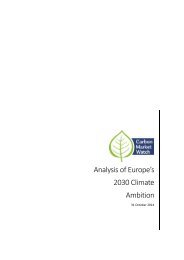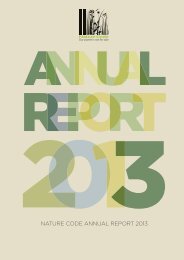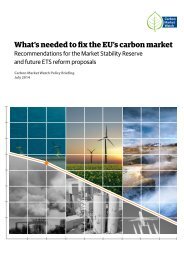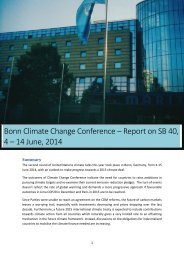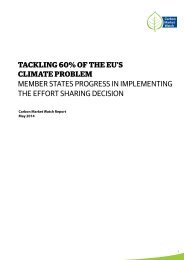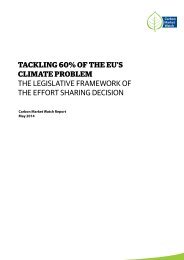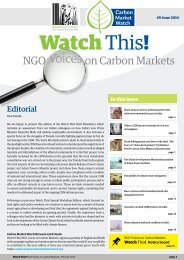Create successful ePaper yourself
Turn your PDF publications into a flip-book with our unique Google optimized e-Paper software.
FLEXIBILITIES<br />
To make it easier to comply with their<br />
emission targets, Member States are allowed<br />
to use flexibilities. <strong>The</strong>se include inter alia:<br />
• Any overachievement of the target in a<br />
certain year can be banked to a future<br />
year or transferred to other Member<br />
States.<br />
• Member States can borrow from the<br />
following year or transfer to another Member State up to 5%<br />
of their annual target.<br />
• Each year, a Member State is entitled to use offsets up to<br />
the equivalent of 3% of its 2005 non-ETS emissions. Unused<br />
entitlements can be transferred to other Member States or<br />
banked for future use. This means that up to 750 Mton CDM/<br />
JI credits can be used during the period from 2013 to <strong>2020</strong><br />
equal to more than 50% of the overall reduction effort ii .<br />
<strong>The</strong> ESD legislative<br />
framework specifies<br />
only what flexibility<br />
options are allowed,<br />
but it remains silent<br />
about the transaction<br />
modalities. This<br />
allows Member States<br />
to structure their<br />
transactions as they<br />
wish, but at the same time does not provide any guidance on how<br />
the trade between Member States could take place. Currently,<br />
there is no mechanism for using domestic offsetting credits to<br />
comply with the ESD although such project offsets could act as<br />
a modality for transfers between Member States under the ESD.<br />
A domestic offsetting mechanism could be coupled to a Green<br />
Investment Scheme which requires the seller country to invest<br />
the revenues of the sales into other mitigation actions.<br />
“Up to 750 million international<br />
credits can be used during the<br />
2013-<strong>2020</strong> period, equal to more<br />
than half of the overall reduction<br />
effort”<br />
COMPLIANCE<br />
<strong>The</strong> <strong>Effort</strong> <strong>Sharing</strong> <strong>Decision</strong> establishes a binding trajectory up to<br />
<strong>2020</strong>. To show compliance with their binding annual ESD targets,<br />
Member States need to follow an annual reporting cycle from 2013<br />
onwards, as also depicted in figure 2 below. This is a distinctive<br />
feature of the ESD instrument, as other elements of the <strong>2020</strong><br />
climate and energy package do not ensure annual compliance up<br />
to <strong>2020</strong>. <strong>The</strong> Renewable Energy Directive for example only has an<br />
indicative trajectory leading up to the binding <strong>2020</strong> targets for<br />
the share of renewable energy in each Member State.<br />
A panel of experts review the national inventory reports that the<br />
Member States submit to the Commission by 15 March each year.<br />
<strong>The</strong> first report is due in 2015. Once this review is completed,<br />
the emission data for each Member State is finalised after which<br />
that country has four months before its compliance (taking into<br />
account the use of flexibilities) is determined. In case of noncompliance,<br />
the Member State is faced with the aforementioned<br />
penalties.<br />
31 July 2014: <br />
-‐ Approximated <br />
GHG inventory of <br />
2013<br />
15 January 2015: -‐ <br />
Report on 2013 <br />
emissions<br />
Ini;al check of <br />
inventories by <br />
Commission<br />
15 March 2015: <br />
-‐ Na;onal Inventory <br />
Report 2013<br />
30 June 2015:<br />
End of review <br />
period<br />
Figure 2: Reporting cycle related to the ESD compliance<br />
15 January 2016: <br />
-‐ Report on intra-‐<br />
MS AEAu transfers <br />
-‐ Report on use of <br />
interna;onal <br />
credits used for <br />
2013 compliance <br />
31 July 2016: <br />
-‐ Report on <br />
jus;fica;on for using <br />
interna;onal credits <br />
from industrial gas <br />
projects<br />
Commission review of inventories<br />
2014 2015<br />
2016<br />
HOW MEMBER STATES ARE DOING<br />
<strong>The</strong> current ESD target, 10% reduction below 2005 emission<br />
levels by <strong>2020</strong>, can be easily met at no net cost to the European<br />
economy and even delivers net benefits to the economy through<br />
efficiency savings. At EU level, an overachievement of this target<br />
of up to 5% by <strong>2020</strong> is already expected iii .<br />
Overall, the majority of Member States are expected to reach their<br />
<strong>2020</strong> target under the <strong>Effort</strong> <strong>Sharing</strong> <strong>Decision</strong>. See figure 3 below.<br />
A thin majority of Member States is expected to overachieve<br />
their target by between 2% and 44% with already implemented<br />
measures. <strong>The</strong> difference between already implemented and<br />
additional planned measures is relatively small for most of them.<br />
This indicates that most Member States would already achieve<br />
their targets as a result of a business-as-usual trajectory and they<br />
therefore did not need to plan any additional measures.<br />
Also, most of the overachievers are countries that are allowed to<br />
increase their emissions. <strong>The</strong> ESD targets are therefore insufficient<br />
as they lock in a business-as-usual scenario.<br />
4





